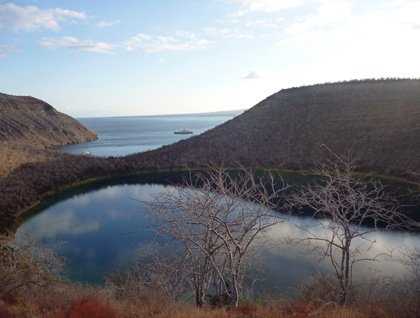Isabela is the largest island in the archipelago, it is made of six large shield volcanoes; this morning we explored the coast right at the base of Alcedo volcano. We landed on a small beach which is one of the places that green sea turtles use for nesting.
Our walk along the National Park’s trail was made on what used to be sea floor, and was uplifted during the beginning of 1954. This path contains large amounts of shells and old dead mangrove trees as evidence of this volcanic event. Among the species that live here, we found Galapagos land iguanas, mockingbirds, and a Galapagos giant tortoise sleeping under the shade of a tree.
As we returned to the landing place, we observed a group of Galapagos penguins, brown pelicans and blue-footed boobies fishing together. After a refreshing swim from the beach, we returned to our ship and started to navigate towards Tagus Cove, which is also found on Isabela Island.
As we dropped anchor inside Tagus Cove, we got ready for an afternoon of snorkeling and kayaking. The weather this afternoon was sunny with nice warm water—perfect for water activities. This month starts the transition between the dry-cold season and the warm-wet season, and we are already observing some subtle changes in the temperature of the water and the air.
After our water activities, we got ready once more to go for a walk to the top of a cinder cone, where we got the best view of Tagus cove and Darwin’s Lake as well as some of the volcanoes of Isabela island. We also had the option of a Zodiac ride along the coast, where we got to see Galapagos penguins, green sea turtles, marine iguanas and Galapagos flightless cormorants.
We returned aboard at the end of the afternoon with new amazing experiences from today.







